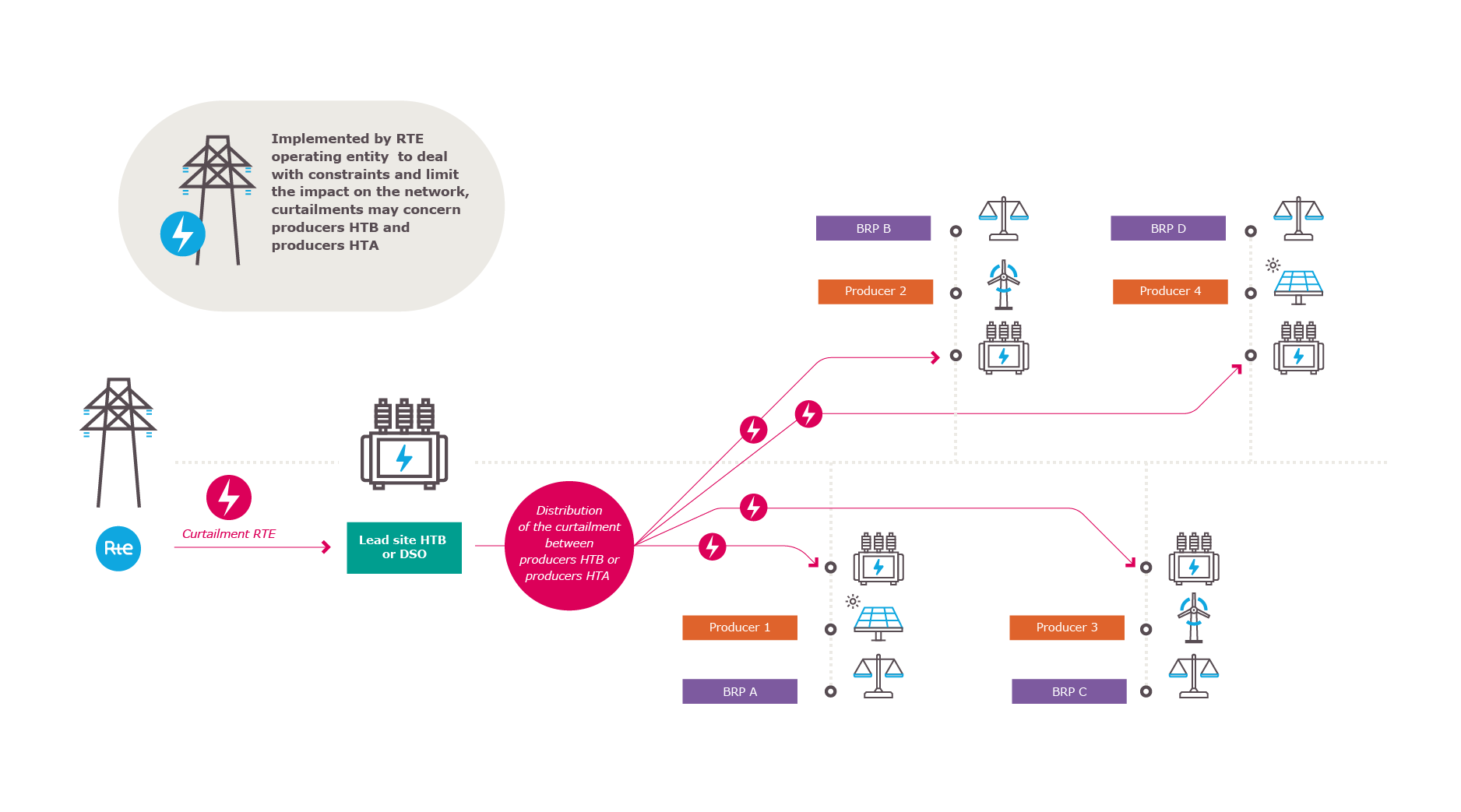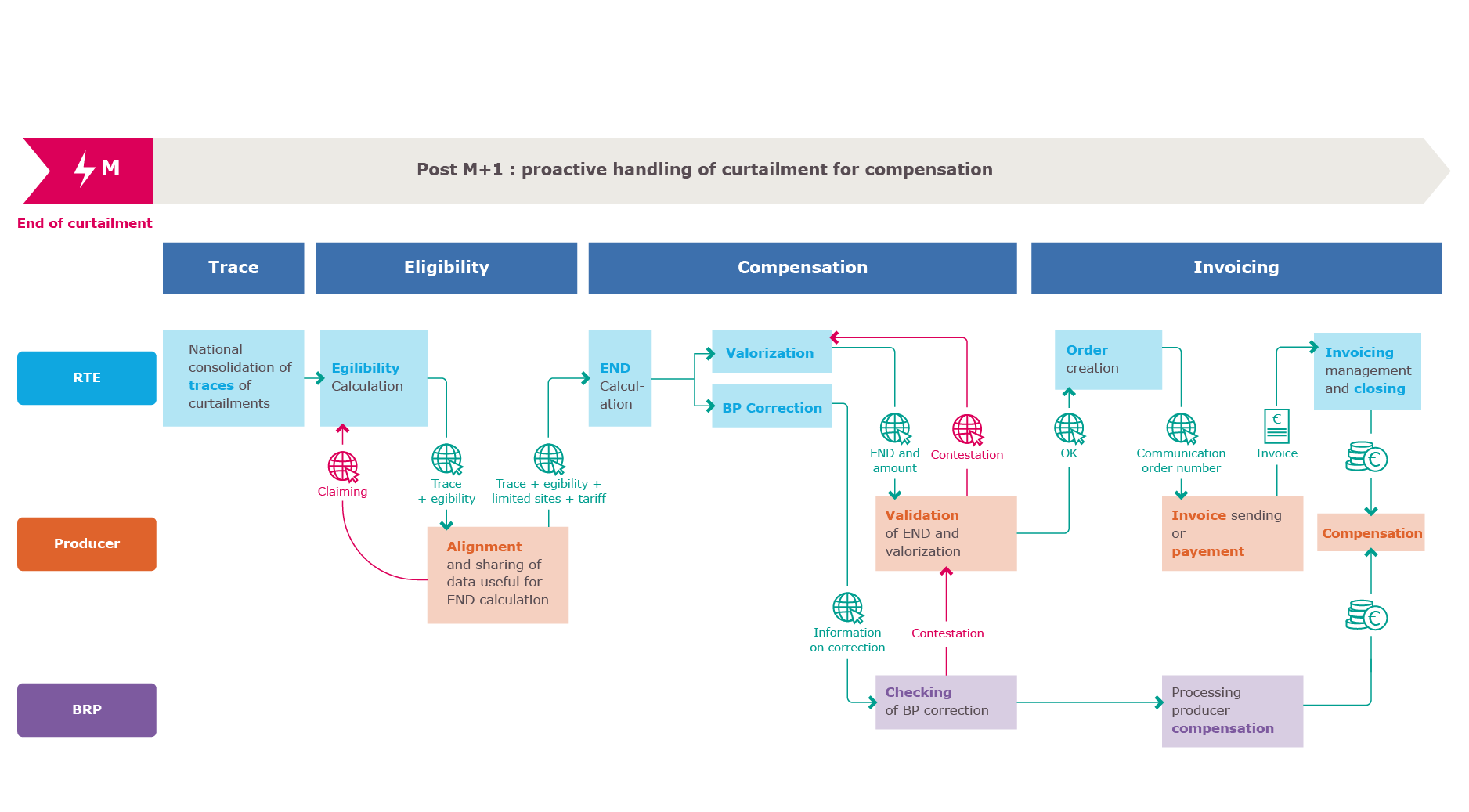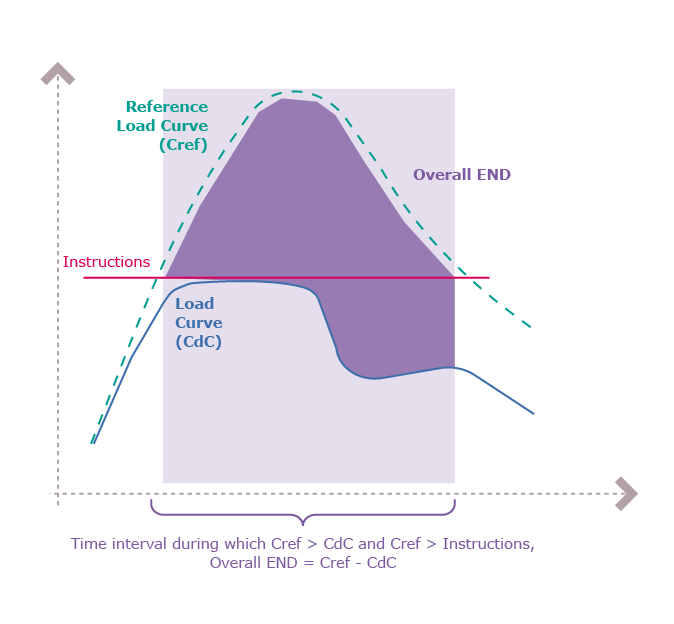Do you have an account?
Why create an account?
After creating an account you will :
- have access to the “favourites” feature,
- be able to download certain data published by RTE,
- have access to forms (PKI certificate, EIC code, Customer questionnaire - KYC),
- have access to notifications.
If you are an RTE customer, feel free to contact your administrator so that he or she can give you access to your company’s services.
+ RTE has adopted a proactive approach to managing these compensations and the associated corrections to balance perimeters. It has also launched a project to industrialise the compensation process. This page will help you implement this change.
Beneficiaries
- HTB onshore renewable energy generators
- Balance Responsible Parties
Context
RTE may need to curtail the injection of onshore renewable energy due to transit constraints, particularly those related to the optimal sizing of the transmission network.
A curtailment refers to a modification in the power flow at the interface between RTE and its customers (CART-P or CART-D signatories). Limitations can be sent to:
- the THB generator
- the HTB lead customer of a Multi-Producer Group (which allocates sub-curtailments among the THB generators who have subscribed to the accounting service)
- the source substation at the interface between the transmission and distribution networks (the DSO then distributes the curtailment between the HTA generators connected to this source substation).
Distribution of curtailments carried out by RTE at customer substation level

Any curtailment may potentially cause damage for generators, resulting in an amount of Energy Not Dispatched (END) on the PTS. This could also affect the Balance Responsible Party due to an imbalance in their balance perimeter.
Curtailments on the PTS
The compensation process for HTB generators is divided into three stages:

Stage 1: Calculating eligibility
The first stage is to determine whether the curtailment qualifies for compensation, in accordance with the commitments set out in the generator system access contract (CART), the provisional management contract or the generator connection agreement.
This stage enables the following elements to be validated between the generator and RTE:
- the curtailment trace (period, setpoint, reason)
- its status: eligible for compensation / potentially eligible for compensation / not eligible for compensation.
It also makes it possible to collect information from the generator:
- any sites that have subscribed to the metering data service, to which the limit has been distributed.
- The tariff of the lead customer or the sites subscribed to the metering service, if they benefit from a support mechanism (with proof), such as a: Compulsory Purchase or Remuneration Supplement.
Stage 2: Calculating and valuing Energy Not Dispatched (END)
Energy Not Dispatched refers to the energy that the Customer is unable to inject into the PTS because of the curtailment. It is calculated, in accordance with Article 7.7 of the Technical Reference Documentation, as the difference between:
- the Reference Load Curve, corresponding to the generator's theoretical production in the absence of curtailment, estimated using the method described in the Technical Reference Documentation
- the Production Measurement Curve, corresponding to the generator's actual production as a result of the curtailment, taken from the metering data.
Calculating END

There are two methods for calculating the Reference Load Curve:
When these methods do not allow to calculate the Reference Load Curve, RTE may request a Reference Curve from the generator. This Generator Reference Load Curve will be sent using the predefined format provided by RTE and can be downloaded via the "Compensation for curtailment" API (see chapter “Planned Changes to industrialise the compensation process”).
At the end of this stage, RTE asks the generator to validate the END of the curtailment.
The financial flows between the parties (including compensation for the generator) and the generator compensation tariffs applied by RTE in the two scenarios below, are described in Article 7.7 of the Technical Reference Documentation.
- Cases requiring balance perimeter correction
For limitations activated after 14 October 2024, a correction to the Balance Perimeter is implemented when the notice period for the curtailment is insufficient for the Balance Responsible Party to (re)balance their perimeter. Article 7.7 of the Technical Reference Documentation specifies the cases in which RTE corrects the balance perimeter by a quantity of energy equal to the previously evaluated amount of END.
In the event of iterations between RTE and the generator at the previous stage to determine an END value, the successive updates to the END will be incorporated into the various M+X correction deadlines for the balance perimeter, even before the generator’s final validation of the END.
Ultimately, in the event of an imbalance, the cost of the imbalance will be allocated to RTE in the Imbalance Adjustment Account.
Any claims on the part of the Balance Responsible Party regarding the value of END must be made via the generator.
As long as the producer has not validated the END, the balance manager can submit his claim to him. If the producer validates the END within fifteen days of the calculation or last update of the END, the Balance Responsible Party nevertheless has an incompressible 15-day period following the calculation or last update of the END to submit a claim via the generator so that it can be taken into account in the nominal compensation process. After this deadline, if the END has been validated by the generator, the claim will still be reviewed by RTE but outside the nominal process, potentially resulting in a longer processing time.
The END update dates can be detected via the « Big Energy Curtailment » API and are displayed in the Services Portal service (see the section below entitled « Tools available to Balance Responsible Parties »).
The financial flows between the parties, including compensation for the generator, following balance perimeter correction, vary depending on the support mechanism benefiting the generator, as described in Article 7.7 of the Technical Reference Documentation.
- Cases not requiring balance perimeter correction
When the curtailment is activated within the notice period, allowing the Balance Responsible Party to rebalance, RTE does not adjust the balance perimeter but compensates the generator for Energy Not Dispatched, in accordance with the CART-P contract. This compensation takes into account the feed-in tariffs the producer benefits from as part of its support mechanism.
Stage 3: Invoicing
Based on the financial flows established in the previous stage, the billing process occurs either between the generator and RTE or between the generator and its Balance Responsible Party
Curtailments on the PDS and impact on Balance Responsible Parties
The conditions for compensating MV generators are the responsibility of the Distribution System Operators, as specified in the MV generator's network access contract (CARD) with the distribution network.
Eligibility for balance perimeter corrections is governed by the contractual framework of the relevant DSO.
In this framework, DSOs report all balance perimeter corrections to RTE caused by the curtailment of HTA sites on their network, regardless of whether the curtailment is activated for RTE's needs or for the DSO’s own requirements.
This data is used to account for HTA curtailments when correcting the balance perimeters of Balance Responsible Parties and to allocate the cost of imbalances in the Imbalance Adjustment Account to the DSO that initiated the curtailment request.
Planned Changes to industrialise the compensation process
Tools available to HV-B generators:
From November 20, 2025, generators will have access to:
- a "View and process curtailments" service deployed on the Services Portal
- a Data Portal API for "Compensation for Curtailment"
to facilitate the implementation of the data exchanges and validations necessary for the HV-B curtailment compensation process.
The use of this service and API should then be prioritised over the current email exchange regarding compensation for limitations.
Depending on the end date of the curtailment, it will continue to be processed by email or will be processed on the Services Portal, according to the following table (a parallel run is planned for curtailments ending during September 2025):
As soon as the service opens, we advise you to provide the tariffs for your sites, including:
- Compulsory Purchase tariff amount in €/MWh + supporting document
- Remuneration Supplement tariff amount in €/MWh + supporting documentation
- Non-subsidised tariff (compensation will be paid at the SPOT price)
This will also give you the opportunity to check the completeness of your sites.
An API test environment is available until the end of 2025 to test your developments (see details below).
Link to the access conditions for the "View and process curtailments" service
Link to swagger for "Compensation for Curtailment” API
Link to the User Guide for “Compensation for Curtailment” API
Tools available to Balance Responsible Parties:
Balance Responsible Parties receive an email at the end of each month detailing the END at the site level and 5-minute intervals for each curtailment where a balance perimeter correction has been made.
From November 20, 2025, they will have access to a Services Portal “View HV-B curtailments” and a Data Portal API “Big Energy Curtailment” to view and download these records. This data will be available for a period of 5 years.
This service and API will also provide updates on the status of the generator’s END processing (validated or not) and indicate how it will be factored into the various M+X variance calculation deadlines.
Transition from email delivry to the service “View HV-B curtailments”
Depending on the end date of the curtailment, it will continue to be sent by email or published on the Services Portal, according to the following table (a parallel run is planned for curtailments ending between September and December 2025):
We invite you to keep any emails you have received regarding curtailments that expire on or before 31st August 2025, as these will not be included in the Services Portal.
Link to access conditions to service “View HV-B curtailments
Transition to the API “Big Energy Curtailment”:
The launch of the service is accompanied by the release of the ‘BIG Energy Curtailment’ API, which contains the same data as the service and allows users to retrieve:
- the list of curtailments and their progress in the imbalance calculation
- the latest updates since a reference date and for each curtailment:
- the END time-serie (in kW) at 15-minute intervals (duplicated at 5-minute intervals within the quarter hour)
- the injection time-serie (in kW) at 5-minute intervals
Link to access conditions to API “Big Energy curtailments”
Link to swagger for "Big Energy Curtailment” API
Link to User Guide for "Big Energy Curtailment” API
Since March 2023, Balance Responsible Parties have had access to imbalances caused by HTA curtailments via the "See valued imbalances" service and its Big Imbalance API.
As of the application date of 14 October 2024, deviations caused by activated HTB curtailments have been aggregated with HTA curtailments in this service and API.
The gaps created by HTA and HTB curtailments are accessible:
- From the service by downloading the "Flexibility_Down" and "Flexibility_Up" files
- From the API via the request for data types Y23 and Y25
Link to Big Imbalance 3.0.4 API implementation guide, applicable on 1 April 2025
Reference documentation
- Technical Reference Documentation - Article 7.7 – Compensation for renewable energy curtailments: wind and onshore photovoltaics
- Technical Reference Documentation Article 8.13 - Standard outline of the contract for access to the Public Transmission System for CART-P generator customers
- Technical Reference Documentation Article 8.8.1 - Contract relating to the Predictive Management of photovoltaic and wind generation
- Technical Reference Documentation Article 8.4 - Outline of the Connection Agreement for generators and/or storage providers - General and Special Conditions
- Market Rules - Chapter 3 - Balance Responsible Party (Correction of balance perimeters: 3.L.5.1.3) (Taken into account in the Imbalance Adjustment Account: 3.Q.5)
Contact
For any questions, please contact RTE-INDEMNISATIONLIMITATIONENR@rte-france.com
